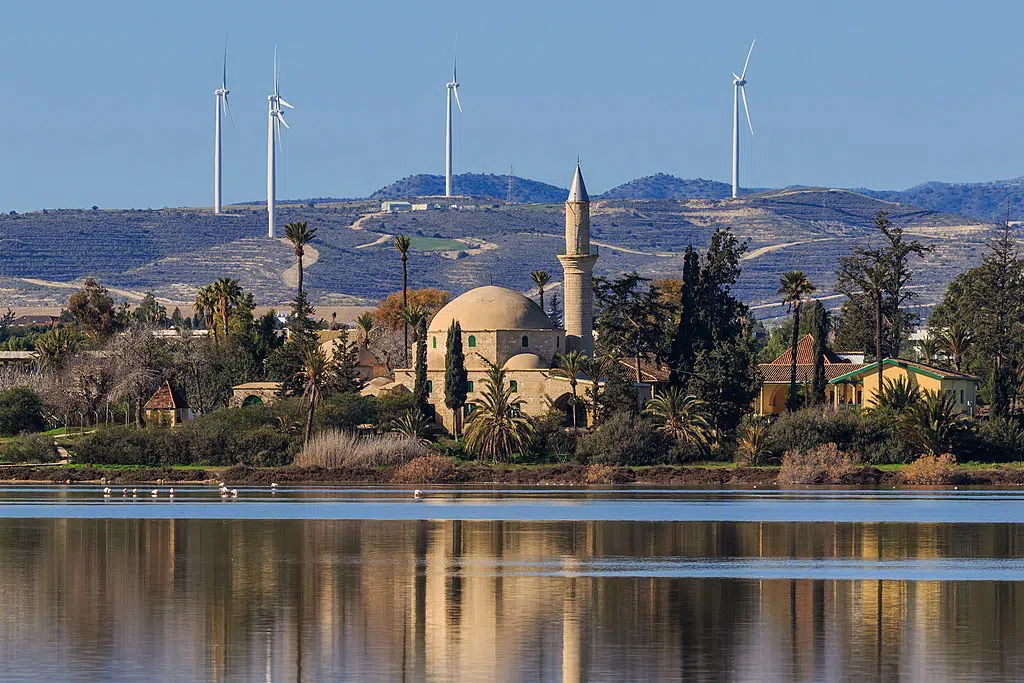
Newly-excavated Bronze Age tombs near the sea in Cyprus revealed the remains of an aristocratic family wearing solid gold necklaces and tiaras, surrounded by grave goods from faraway lands, showing the extensive trade networks of the time.
A seal from Mesopotamia with cuneiform writing was also found at the site.
Researchers note that some of the jewelry that had adorned the deceased looks a great deal like the necklaces worn by Egypt’s famed Queen Nefertiti.
Archaeologists discovered a hoard of approximately 500 artifacts at the site, dating back to 1500 and 1350 B.C., according to a report from Smithsonian Magazine.
Cyprus tombs show rich material culture of Larnaca area during the Bronze Age
The two tombs are a treasure trove for the researchers, who found a total of 155 skeletons, one of which was of child, who was adorned in gold. The tombs are thought to be of several generations of a ruling family at the time.
Entombed one atop the other, the unearthing of the remains took several years because of the state the bones were in.
Peter Fischer, the leader of the “New Swedish Cyprus Expedition,” told the Daily Mail in a statement “The finds indicate that these are family tombs for the ruling elite in the city. For example, we found the skeleton of a 5-year-old with a gold necklace, gold earrings and a gold tiara. This was probably a child of a powerful and wealthy family.”
Although the archaeologist started working at the site, called Hala Sultan Tekke, in 2010, the tombs were not discovered until eight years later. According to the archaeologist, so far in 2021 his meticulous excavations of the tombs have uncovered an ivory comb, scarab amulets, a vessel shaped like a cow and other ceramics.
Fischer explains “The way that the ceramics changed in appearance and material over time allows us to date them and study the connections these people had with the surrounding world.”
One of the most spectacular finds at the Cyprus site is that of a gold pendant that resembles one worn by Queen Nefertiti, as seen in artistic representations of her. She ruled Egypt with her husband Akhenaten, at the very time the tombs were being used by the family.
The pendant shows a lotus flower that is inlaid with gemstones.
Another find made by the archaeologists include that of a cylindrical seal which has cuneiform writing on it in the language used in Mesopotamia. “The text consists of three lines and mentions three names,” Fischer explains. “One is Amurru, a god worshipped in Mesopotamia. The other two are historical kings, father and son, who we recently succeeded in tracking down in other texts on clay tablets from the same period, the 18th century B.C.”
Fischer adds, “We are currently trying to determine why the seal ended up in Cyprus more than (600 miles) from where it was made.”
An amazing cache of rare gemstones was also found by the team of archaeologists, including a red carnelian from India, a blue lapis lazuli from Afghanistan and even amber, which they believe originated from the Baltic Sea, Smithsonian reports. Incredibly, the remains of a fish that had been imported from the Nile River in Egypt were also found at the site of the tombs.
Fischer states that the sheer number of objects found at the site which had origins far afield tells the story about the vast trade networks of which Cyprus was a part as far back as the Bronze Age. “What fascinates me most is the wide-ranging network of contacts they had 3,400 years ago,” he states.
Now, the only things that remains is to uncover the secrets that are locked in the skeletons themselves by means of DNA analysis.
Fisher says that this will eventually show “how the different individuals are related with each other and if there are immigrants from other cultures, which isn’t unlikely considering the vast trade networks.”
During the second half of the second millennium B.C, the area later known as Hala Sultan Tekke was used as a cemetery by the people who lived in Dromolaxia Vizatzia, a large Late Bronze Age town a few hundred meters to the West.
Originally identified as an archaeological site following looting that took place there in the 1890s, numerous tombs from the Late Bronze Age date (around 1650-1100 BC) with their spectacular contents were excavated by the British Museum in 1897-1898 directed by Henry Beauchamp Walters and then John Winter Crowfoot; the finds were divided between the British Museum and the Cyprus Museum.
The contemporary settlement was identified by Swedish archaeologist Arne Furumark in 1947 and some preliminary excavations were conducted by the Department of Antiquities. A part of this town, which proved to be a major urban center of Late Bronze Age Cyprus, was excavated from the 1970s onward by a Swedish archaeological mission led by Professor Paul Åström, known as the Swedish Cyprus Expedition.
See all the latest news from Greece and the world at Greekreporter.com. Contact our newsroom to report an update or send your story, photos and videos. Follow GR on Google News and subscribe here to our daily email!



